Exploring The Importance of Proper Ventilation in Plumbing Systems
Exploring The Importance of Proper Ventilation in Plumbing Systems
Blog Article
Just about everyone has got their private opinion when it comes to The Upsides of Proper Ventilation in Plumbing Design.

Appropriate ventilation in plumbing systems is frequently neglected, yet it is vital for preserving the functionality and safety and security of your home's plumbing. Ventilation aids control air pressure, prevent the buildup of hazardous gases, and make certain the efficient removal of waste. In this overview, we will certainly discover the significance of proper plumbing ventilation, exactly how it works, and the benefits it gives your plumbing system.
Comprehending Ventilation in Plumbing
Ventilation in plumbing describes the network of pipelines that permit air to move with the drain system. These vents serve multiple purposes, consisting of managing air pressure within the pipes, preventing sewer gases from going into the home, and aiding in the smooth flow of wastewater.
Just How Air Flow Functions in Pipes Solutions
Air Pressure Policy
Correct ventilation maintains well balanced air pressure within the pipes system. When water flows via pipes, it displaces air. Without ample ventilation, this variation can create unfavorable stress, causing reduce drains or siphoning of water from traps, which can create undesirable odors to leak right into the home.
Avoiding Drain Gas Build-up
Among the most vital features of pipes vents is to stop sewage system gases, such as methane and hydrogen sulfide, from accumulating within the home. These gases can position major health and wellness dangers and are extremely combustible. Vent pipelines allow these gases to leave securely outdoors.
Assisting in Waste Removal
Air flow assists in the reliable removal of wastewater by avoiding airlocks in the drain system. When air can stream easily via the vents, it enables water and waste to flow smoothly via the pipes, decreasing the threat of blockages and backups.
Sorts Of Plumbing Vents
Key Stack Vent
The major stack air vent, likewise known as the vent pile, is the main air vent in a plumbing system. It expands from the main drain align through the roof covering, allowing gases to get away and fresh air to get in the system.
Branch Vent
Branch vents connect to the main pile vent and offer private components, such as sinks, bathrooms, and showers. These vents make certain that each fixture has sufficient ventilation to operate correctly.
Air Admission Valve (AAV).
An Air Admittance Valve (AAV) is a one-way valve that enables air to enter the pipes system without the need for a standard air vent pipeline expanding via the roofing. AAVs are typically used in improvements or areas where installing a common air vent is impractical.
Signs of Poor Air Flow in Plumbing.
Slow Draining Fixtures.
If your sinks, tubs, or toilets are draining pipes gradually, it could be an indication of poor ventilation. Poor air circulation can create a vacuum cleaner result, making it difficult for water to drain pipes effectively.
Gurgling Sounds.
Gurgling sounds originating from drains are typically an outcome of air being drawn with water traps due to negative pressure in the pipes. This is a clear indicator of inadequate ventilation.
Undesirable Smells.
Drain smells inside your home are a warning that your pipes system is not appropriately ventilated. This might imply that sewage system gases are not being appropriately aired vent outside, resulting in possibly harmful problems.
Common Air Flow Errors.
Poor Vent Sizing.
Using small air vent pipes can cause poor air circulation and pressure inequalities in the system. It's important to utilize vents that meet the specific needs of your pipes system.
Improper Vent Placement.
Placing vents too much from the components they offer can decrease their effectiveness. Appropriate positioning makes certain that air can stream freely and efficiently with the system.
Disregarding Code Demands.
Building regulations provide details guidelines for pipes ventilation. Ignoring these codes can lead to a system that stops working to function appropriately and may bring about expensive repairs or health hazards.
Advantages of Proper Air Flow.
Boosted System Efficiency.
Effectively ventilated pipes systems run more effectively, with less obstructions, faster draining pipes, and much less stress on the pipes. This performance extends the life expectancy of the plumbing system.
Improved Air Top Quality.
By avoiding drain gases from entering your home, appropriate air flow adds to much better interior air high quality, making your living setting healthier and more comfortable.
Avoiding Water Damages.
Sufficient ventilation helps prevent water from being siphoned out of catches, which can cause sewer gases entering the home and creating water damage over time.
Actions to Guarantee Correct Air Flow.
Consulting Plumbing Codes.
Constantly consult regional plumbing codes when creating or customizing your plumbing system. These codes offer the necessary guidelines for appropriate airing vent and guarantee your system meets safety and security standards.
Normal Inspection and Upkeep.
Regular assessments can help recognize prospective air flow issues prior to they come to be major problems. Maintenance jobs, such as cleaning up vent pipelines and looking for obstructions, are vital for keeping the system in good working order.
Specialist Installation.
For new installations or significant alterations, it's a good idea to hire a professional plumbing technician. They have the experience to make certain the ventilation system is correctly created and set up according to code.
Final thought.
Proper air flow is a critical element of any plumbing system, making sure that it works successfully and securely. By comprehending the importance of air flow, acknowledging the indicators of poor air flow, and taking actions to keep your system, you can stop costly issues and secure your home's air top quality.
4 Things You Should Know About Your Plumbing Vents
What Plumbing Vents Are
Also called a vent stack, a plumbing vent is a vertical pipe attached to your drain line that runs through your roof. The plumbing vent pipe, or plumbing air vent, removes gas and odors from your plumbing system and allows fresh air to enter the pipes, helping the water to flow out of the drain pipes.
What Plumbing Vents Do
Plumbing vents have two basic functions. One of which is to allow unpleasant smelling wastewater and sewer gasses to escape your plumbing system instead of entering your home. Plumbing vent pipes are typically located on roofs, away from windows, to ensure the fumes exit the home completely.
The other function of the plumbing vent is to move fresh air into your plumbing system. This helps move water through every plumbing fixture in your house, like toilets and sink drains. Think of the way in which you need to let a little air into the bottle as you pour soda in order to make the drink flow smoothly.
Different Types of Plumbing Vents
True vent: This is the most common vent option. In simplest terms, a true vent is a vertical pipe attached to your drain line that exits through the roof. They often function as the main vent that other fixtures can connect to. Re-vent pipe or auxiliary vent: Attached to the drain line near specific plumbing fixtures, re-vent pipes run up and over to connect to the main vent. Common vent: Two plumbing fixtures installed on opposite sides of a wall are typically tied into the vent stack using something known as a sanitary cross. Wet vent: This venting option operates as a drain pipe and a vent at the same time. Wet vent drainage systems drain water from one fixture while venting the air from another. Although they’ve been used for over 100 years, wet vent systems have only recently been added to the plumbing code in many areas. If you’re planning on installing one in a bathroom remodel, make sure you check your local code prior to construction. Loop vent: For free-standing fixtures like kitchen island sinks, loop vents are ideal. These vent pipes run under the floor, rise from the P-trap, and create a loop inside the cabinet sink. Air admittance valve: An AAV is a one-way mechanical valve typically installed at the site of the plumbing fixture. AAVs allow venting to occur without having to tie into a larger venting system. They’re ideal for venting fixtures where you aren’t able to easily connect to an existing vent system. Common Plumbing Vent Issues
Although vent pipes typically don’t have water flowing through them, they’re still subject to many typical plumbing issues. For example, clogs are one of the most common problems associated with sewer vent pipes. If your vent pipe gets clogged, all of your plumbing fixtures tied into the vent stack will be affected.
A sink with a slow drain that bubbles and gurgles or a strong sewage smell around your toilet are both indicators that your toilet vent pipe is clogged. Because most vent pipes exit through the roof, old leaves, twigs or even a bird’s nest could be clogging the pipe.
Clogs in your vent pipe system cause a buildup of negative pressure, meaning that water won’t be able to flow out of your home very well. It’s similar to putting your finger over the opening of a straw to trap water inside. When you remove your finger, the water is able to flow out of the straw.
If you suspect you have any blockage in your vent, make sure you have a professional come examine the situation. Left unchecked, a blocked air vent can lead to other costly repairs, like leaks and sediment buildup.
Under Pressure
Pipe vents are essential aspects of a home’s plumbing system. Owning a home means learning about all sorts of things you never put much thought into before. But by understanding as much as you can about the important systems of your home, you can keep those budgets intact and those anxiety levels low.
https://www.homeserve.com/en-us/blog/home-improvement/plumbing-vents/

I'm just very curious about What Is a Plumbing Vent and Why Is It Important and I really hope you liked my piece. Liked our article? Please share it. Help someone else discover it. We treasure reading our article about What Are Plumbing Vents and Why Are They Important?.
Schedule Today Report this page